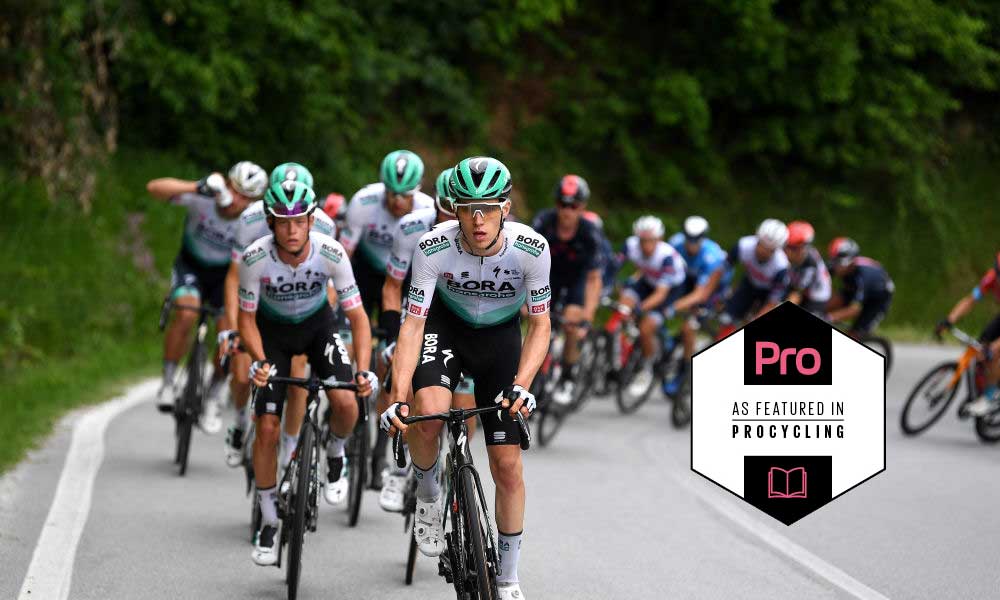Giro d'Italia stage 3 analysis: Bora-Hansgrohe's almost-perfect day
How Bora-Hansgrohe's work was undone by breakaway survivor Taco van der Hoorn

Can you have a perfect day if you don’t win? This is one of those questions posed by professional cycling, where there can only be one winner at the end of the day, no matter what happens behind. Bora-Hansgrohe rode an absolutely perfect day on stage 3 of the Giro d'Italia, until they didn’t.
Of course, this is delusional: how could a team put in a consummate performance if they then didn’t finish it off with a win. Yet Bora pulled on the front all day for their designated sprinter, Peter Sagan, dropping their rivals on the climbs and seemingly setting up the Slovakian for victory. There was one problem, though. Sagan finished third.
Stage 3 of the Giro saw a monumental win for Taco van der Hoorn, the lone survivor of a breakaway that formed with 188km to go. Breakaways aren’t supposed to succeed on days that are designated as sprint stages. Van der Hoorn couldn’t believe it, and neither could the peloton, who came in at just four seconds behind. When Van der Hoorn attacked his final break companion, Simon Pellaud, with 8.8km to the line, his advantage stood at just 39 seconds.
Up to this point, Bora had ridden almost flawlessly, dropping their fastest rivals and all-but delivering Sagan to the finish in Canale. If it wasn’t for Van der Hoorn’s freak win, maybe Bora’s day really would have been perfect.
The performance and lack of a result bring to mind stage 7 of last year’s Tour de France, where the German team ripped the race to shreds in the crosswinds between Millau and Lavaur. On that day, Bora-Hansgrohe used the hills early in the stage to put pressure on other fast men, dropping some of the leading sprinters just 8km in. Again, the team was charged with putting Sagan in an excellent position, and yet Wout van Aert ended up winning, with Bora’s Slovakian in 13th, scuppered by a mechanical in the sprint.
This time, the squad used the hills midway through to really thin out the bunch. First to go was Lotto-Soudal’s Caleb Ewan, then quickly after, yesterday’s stage winner, Tim Merlier, fell out the back of the peloton. Giacomo Nizzolo looked like he might be able to hang on, but followed his sprinting colleagues in struggling up the hills of Piedmont, with the damage happening on the Castino and the Manera.
While Fernando Gaviria and Elia Viviani remained with the bunch, the idea was that they would have put so much effort into hanging on that they wouldn’t be able to kick away from Sagan at the end. So it proved, with only Davide Cimolai beating him in the sprint. The snag being that Van der Hoorn had hung onto his slim margin out in front.
The latest race content, interviews, features, reviews and expert buying guides, direct to your inbox!
Where did Bora-Hansgrohe go wrong? Perhaps they had made a mistake in allowing eight riders to go up the road in the ridiculously early break, but then no-one would have ever imagined that those men could stay away. Possibly, they burned their matches too early, but they clearly had to try and push Sagan’s rivals to their limit on the climbs, in order to give the former world champion the best chance of a stage victory. Maybe they were convinced of their dominance too early, and could taste the victory Nutella that is made in Alba, where the Giro passed through.
On the Eurosport analysis post-race, former cyclist and team manager Brian Smith said that Bora should have collaborated more with the other sprint teams, particularly the ones that had an interest in bringing back Van der Hoorn at the end, in UAE Team Emirates and Cofidis. Yet this would have defied the logic of Bora’s plan in the first place, to use all they could to put Sagan in the best position in the sprint.
The team still had five riders in front of the Slovakian with 26km to go, and yet this strength in numbers had seemingly evaporated by the final 10km. Sagan is normally good on his own though in a sprint, and rarely requires a lead-out like other riders, so this wasn’t a cause for alarm. However, no one had accounted for someone being so strong from the breakaway, out in front in miserable conditions for four hours, and this is where the win slipped through the German squad’s fingers, with a late panic from UAE and Cofidis too little, too late. It was Van der Hoorn’s day, not Bora’s after all.
Adam Becket is Procycling magazine's staff writer.
Procycling magazine: the best writing and photography from inside the world's toughest sport. Pick up your copy now in all good newsagents and supermarkets, or get a Procycling subscription.
Adam Becket is the staff writer for Procycling magazine. Prior to covering the sport of cycling, he wrote about ecclesiastical matters for the Church Times and politics for Business Insider. He has degrees in history and journalism. A keen cyclist himself, Adam’s favourite race is the Tour of Flanders or Strade Bianche, and he can't wait to go to the Piazza del Campo for the end of the race one day.